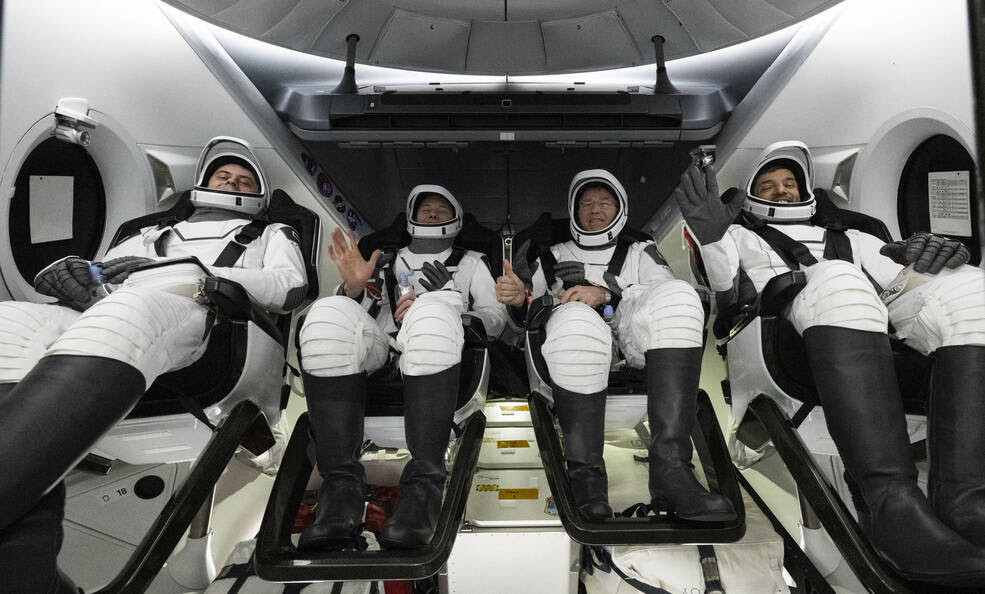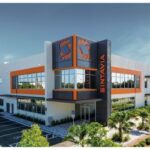UAE’s Sultan Al Neyadi and fellow astronauts return to Earth

Crew-6 had spent 186 days on the International Space Station
UAE astronaut Sultan Al Neyadi, NASA astronauts Stephen Bowen and Woody Hoburg, and Roscosmos cosmonaut Andrey Fedyaev have returned to Earth safely after their SpaceX Dragon Endeavour spacecraft splashed down with parachutes in the Atlantic Ocean off the coast of Jacksonville, Florida, at 08:17am (Gulf Standard Time/EDT12:17am) on September 4, 2023.
The four astronauts representing the NASA-led Crew-6 (Expedition 69) mission have spent the last 186 days (six months) onboard the International Space Station (ISS) in low-Earth orbit.

Al Neyadi Bowen, Hoburg, and Fedyaev travelled 127.138km (78,875,292 miles) during their 186-day-long mission and completed 2,976 orbits around Earth.
The crew undocked from the ISS at 11:05am (Gulf Standard Time) on September 3, 2023, to begin the trip home.
Delayed return
NASA delayed their return to Earth on account of Hurricane Idalia in Florida.
Al Neyadi, 42, representing the UAE space programme led by the Dubai-based Mohammed Bin Space Centre (MBRSC), has set a record for conducting the longest-staffed Arab space flight and becoming the first Arab astronaut to undertake a spacewalk, which he did on April 28, 2023, paired with a NASA astronaut.
Al Neyadi was a flight specialist on the Crew-6 team.
Teams on Megan, the SpaceX surface recovery ship in the Atlantic Ocean, including two fast boats, secured the Dragon spacecraft and ensured the spacecraft was safe for the recovery effort on September 4, 2023.
Megan recovery ship
As the fast boat teams completed their work, the recovery ship moved into position to hoist Dragon onto the main deck with the four astronauts inside.
Once on the main deck of the recovery ship, the astronaut crew were taken out of the spacecraft and received medical checks before taking a helicopter ride to board an aircraft for NASA’s Johnson Space Center in Houston, Texas.
The Crew-6 mission was the first spaceflight for Al Neyadi, Hoburg, and Fedyaev. Bowen has logged 227 days in space over four flights.

With the safe return to Earth of Crew-6 in their SpaceX Dragon Endeavour spacecraft off the coast of Jacksonville, Florida, early on September 4 morning, NASA’s SpaceX Crew-6 has completed the US space agency’s commercial crew rotation mission to the ISS.
Bill Nelson, NASA Administrator, said: “After spending six months aboard the International Space Station, logging 79 million miles [127.138km] during their mission, and completing hundreds of scientific experiments for the benefit of all humanity, NASA’s SpaceX Crew-6 has returned home to planet Earth.
‘3-nation crew’
“This international crew represented three nations, but together, they demonstrated humanity’s shared ambition to reach new cosmic shores. The contributions of Crew-6 will help prepare NASA to return to the Moon under Artemis, continue onward to Mars, and improve life here on Earth,” Nelson added.
The Crew-6 mission lifted off at 08:34am Gulf Standard Time (12:34am EST) on March 2, 2023, on a SpaceX Falcon 9 rocket inside a SpaceX Dragon spacecraft from NASA’s Kennedy Space Center in Florida.
About 25 hours later, their Dragon spacecraft docked at the ISS Harmony module’s space-facing port.
On May 6, 2023, the crew completed a port relocation manoeuvre to the Earth-facing port ahead of the arrival of a SpaceX Dragon cargo spacecraft carrying new solar arrays, science investigations, and supplies to the ISS.
Benefitting humanity
The Crew-6 members contributed to various science and maintenance activities and technology demonstrations throughout their mission.
Bowen conducted three spacewalks, joined by Hoburg for two and Al Neyadi for one, preparing the ISS for and installing two new IROSAs (International Space Station Roll-Out Solar Arrays) to augment power generation for the station.
Crew-6 team conducted hundreds of experiments and technology demonstrations, including assisting a student robotic challenge, studying plant genetic adaptations to space, and monitoring human health in microgravity to prepare for exploration beyond low-Earth orbit and to benefit life on Earth.
The astronauts also released Saskatchewan’s first satellite, which tests a new radiation detection and protection system derived from melanin, found in many organisms, including humans.
Reusable Dragan spacecraft
This was the fourth flight of the Dragon spacecraft, named Endeavour by retired NASA astronauts Bob Behnken and Doug Hurley on its first voyage for NASA’s SpaceX Demonstration Mission 2.
The spacecraft will return to Florida for inspection and processing at SpaceX’s refurbishing facility at Cape Canaveral Space Force Station, where teams will inspect the spacecraft, analyse data on its performance, and prepare it for its next flight.
The Crew-6 mission was part of NASA’s Commercial Crew Programme, and its return to Earth follows the launch of NASA’s SpaceX Crew-7, which docked to the ISS on August 27, 2023, beginning another long-duration science expedition.
Featured image: Roscosmos cosmonaut Andrey Fedyaev (left), NASA astronaut Warren “Woody” Hoburg (second from left), NASA astronaut Stephen Bowen (second from right), and UAE astronaut Sultan Al Neyadi (right), are seen inside their SpaceX Dragon Endeavour spacecraft onboard Megan, the SpaceX surface recovery ship, shortly after having splashed down safely in the Atlantic Ocean off the coast of Jacksonville, Florida, on September 4, 2023. Image: NASA/Joel Kowsky
Last Updated on 12 months by Arnold Pinto












